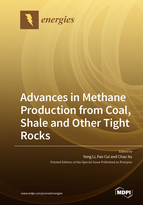Advances in Methane Production from Coal, Shale and Other Tight Rocks
A special issue of Energies (ISSN 1996-1073). This special issue belongs to the section "H3: Fossil".
Deadline for manuscript submissions: closed (31 August 2022) | Viewed by 18126
Special Issue Editors
Interests: coal and coalbed methane; unconventional natural gas/oil resources; sedimentology
Special Issues, Collections and Topics in MDPI journals
Interests: applied geophysics; ground penetrating radar method and technology; 3D seismic inversion of coalfield; basic research on transparent mine technology
Special Issues, Collections and Topics in MDPI journals
Interests: coalbed methane geology; rock mechanics; multi-physics coupling; coalbed methane drainage and technology; coal mine methane drainage and technology
Special Issues, Collections and Topics in MDPI journals
Special Issue Information
Dear Colleagues,
Global demand for energy, directives to reduce carbon dioxide emissions, and technological advancements in horizontal drilling and hydraulic fracturing have spurred a rapid increase in alternative and unconventional energy production over the past decade. The application of new technologies has enabled natural gas and shale oil to be economically produced from shale and other unconventional formations. Further, various methods have been adopted to improve gas recovery, including but not limited to high-precision characterization of coal and shale reservoirs at multiscales, fast drilling and completion of wells with long laterals as well as large-scale volume fracturing, and new technologies such as multiple well-type development, fluid injection, nano-flooding, and enhancing biogenic methane generation methods.
The aim of this Special Issue is to report on the state of the art in fundamental discipline application to methane production and associated challenges in geoengineering activities. We are particularly interested in the three levels of methane and other hydrocarbon production issues, geological and hydrological controls on the accumulation of hydrocarbon, coupled thermal-hydromechanical–chemical processes influencing methane migration, and new technologies and related field tests applied in hydrocarbon production in coal mines and oil fields. We hope to focus both on progress in new methods and on new technique development. We welcome both original research and review articles
Dr. Yong Li
Prof. Dr. Fan Cui
Dr. Chao Xu
Guest Editors
Manuscript Submission Information
Manuscripts should be submitted online at www.mdpi.com by registering and logging in to this website. Once you are registered, click here to go to the submission form. Manuscripts can be submitted until the deadline. All submissions that pass pre-check are peer-reviewed. Accepted papers will be published continuously in the journal (as soon as accepted) and will be listed together on the special issue website. Research articles, review articles as well as short communications are invited. For planned papers, a title and short abstract (about 100 words) can be sent to the Editorial Office for announcement on this website.
Submitted manuscripts should not have been published previously, nor be under consideration for publication elsewhere (except conference proceedings papers). All manuscripts are thoroughly refereed through a single-blind peer-review process. A guide for authors and other relevant information for submission of manuscripts is available on the Instructions for Authors page. Energies is an international peer-reviewed open access semimonthly journal published by MDPI.
Please visit the Instructions for Authors page before submitting a manuscript. The Article Processing Charge (APC) for publication in this open access journal is 2600 CHF (Swiss Francs). Submitted papers should be well formatted and use good English. Authors may use MDPI's English editing service prior to publication or during author revisions.
Keywords
- fundamental research in geology, geomechanics, and geofluids
- coal mine safety issues and methane extraction advances
- real-time detection technology of mine disaster source
- recovery mechanisms of oil and gas from heterogeneous reservoirs
- enhanced oil/gas production using CO2, N2, and other mixed gases
- numerical and analytical modeling in predicting production performance
- advances in the use of artificial intelligence for the development of geofluid resources








